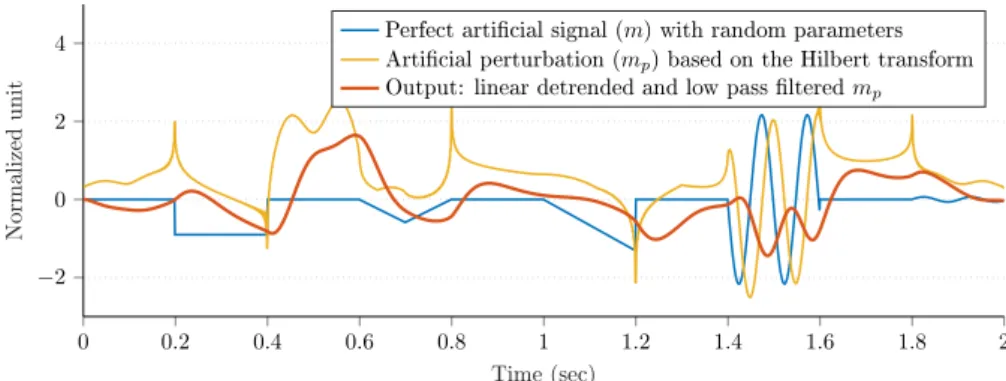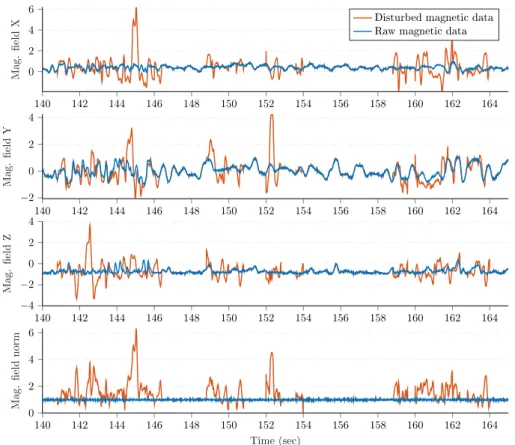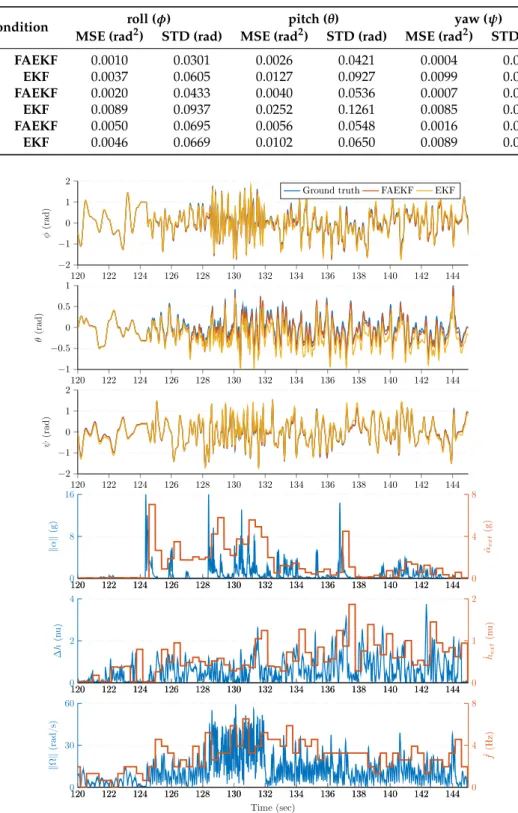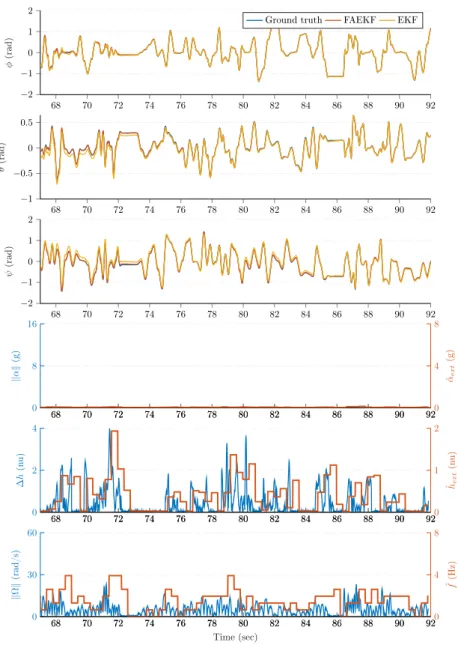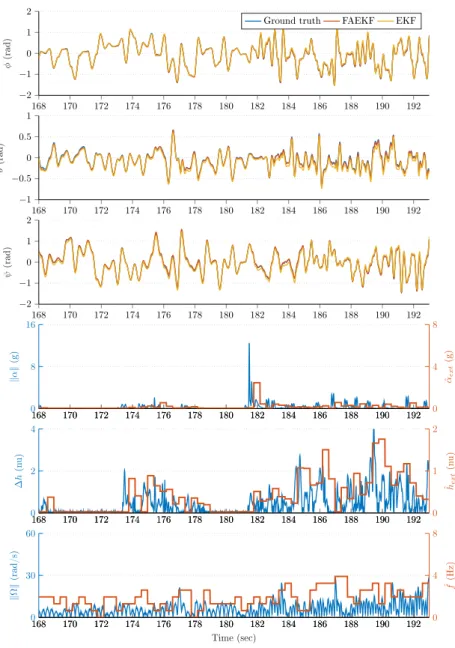Article
A Novel Fuzzy-Adaptive Extended Kalman Filter for Real-Time Attitude Estimation of Mobile Robots
Ákos Odry1,* , Istvan Kecskes1 , Peter Sarcevic2 , Zoltan Vizvari3 , Attila Toth4 and Péter Odry1
1 Department of Control Engineering and Information Technology, University of Dunaújváros, Táncsics Mihály u. 1, 2400 Dunaújváros, Hungary; kecskes.istvan@gmail.com (I.K.); podry@uniduna.hu (P.O.)
2 Technical Department, Faculty of Engineering, University of Szeged, Moszkvai krt. 9, 6725 Szeged, Hungary;
sarcevic@mk.u-szeged.hu
3 Department of Environmental Engineering, Faculty of Engineering and Information Technology, University of Pécs, Boszorkány út 2, 7624 Pécs, Hungary; vizvari.zoltan@mik.pte.hu
4 Institute of Physiology, Medical School, University of Pécs, Szigeti út 12, 7624 Pécs, Hungary;
attila.toth@aok.pte.hu
* Correspondence: odrya@uniduna.hu
Received: 21 December 2019; Accepted: 29 January 2020 ; Published: 1 February 2020 Abstract: This paper proposes a novel fuzzy-adaptive extended Kalman filter (FAEKF) for the real-time attitude estimation of agile mobile platforms equipped with magnetic, angular rate, and gravity (MARG) sensor arrays. The filter structure employs both a quaternion-based EKF and an adaptive extension, in which novel measurement methods are used to calculate the magnitudes of system vibrations, external accelerations, and magnetic distortions. These magnitudes, as external disturbances, are incorporated into a sophisticated fuzzy inference machine, which executes fuzzy IF-THEN rules-based adaption laws to consistently modify the noise covariance matrices of the filter, thereby providing accurate and robust attitude results. A six-degrees of freedom (6 DOF) test bench is designed for filter performance evaluation, which executes various dynamic behaviors and enables measurement of the true attitude angles (ground truth) along with the raw MARG sensor data. The tuning of filter parameters is performed with numerical optimization based on the collected measurements from the test environment. A comprehensive analysis highlights that the proposed adaptive strategy significantly improves the attitude estimation quality. Moreover, the filter structure successfully rejects the effects of both slow and fast external perturbations. The FAEKF can be applied to any mobile system in which attitude estimation is necessary for localization and external disturbances greatly influence the filter accuracy.
Keywords: adaptive filter; attitude estimation; fuzzy logic; inertial measurement unit; extended Kalman filter; sensor fusion
1. Introduction
1.1. Survey on Attitude Estimation
The microelectromechanical systems-based (MEMS-based) relative localization problem is a recent topic, which has been widely investigated in many areas including robotics and control [1–8], healthcare and rehabilitation [9–11], consumer electronics mobile devices [12–14], and automated driving and navigation [15–18], both in industry and in scientific research. Independent from the application, accurate and robust attitude estimation is a crucial task to be solved, especially if the results are to be incorporated into unstable closed-loop systems, such as the control algorithms of mobile robots and unmanned aerial vehicles (UAVs) [1].
Sensors2020,20, 803; doi:10.3390/s20030803 www.mdpi.com/journal/sensors
The MEMS inertial measurement unit (IMU), composed of tri-axis MEMS accelerometer, gyroscope, and magnetometer sensors, also known as the measurement system of magnetic, angular rate, and gravity (MARG) sensor arrays, is the most commonly utilized device to track the real-time orientation of mobile platforms at present. The low-cost, low power consumption, and small size characteristics meet technological requirements, and therefore these devices have been widely utilized in embedded systems, where the filtering algorithm is executed by a microprocessor. As a result, an attitude and heading reference system (AHRS) has been formed, which provides the complete orientation measurement relative to the Earth’s gravitational and magnetic fields (global reference system), where the attitude denotes the roll and pitch angles, whereas heading refers to the yaw Euler angle [19]. The role of the aforementioned filtering algorithm is to combine the individual features of each sensor and provide both properly smoothed and robust attitude results with regard to the global reference system, in either Euler angles or quaternions. The most common method applied in sensor fusion techniques synthesizes the short-term accuracy of gyroscope-based attitude realizations and the accelerometer and magnetometer provide rough, low-frequency attitude corrections. This technique cancels the accumulated error (drift), smooths the signals, and produces long-term stable outputs if the IMU is in stationary states. Significant decrease in estimation performance arises when external disturbances are present, such as external accelerations, vibrations, and magnetic distortions, which prevent the utilization of the pure gravity and local magnetic field vectors in the calculation of the direction cosine matrix (DCM). The following paragraphs discuss the solutions provided in the literature.
Among recent developments, the Kalman filter (KF)—by different variants, such as stochastic approaches—and complementary filter (by frequency domain methods), both augmented with the intelligent use of deterministic techniques, have become the most popular methods for robust attitude determination [20]. Deterministic techniques have been shown to solve Wahba’s problem [21] and provide attitude estimation based on gravity and magnetic field observations. The fundamental solutions are three-axis attitude determination (TRIAD), which produces suboptimal attitude matrix estimation by the construction of two triads of orthonormal unit vectors, and the QUaternion ESTimator (QUEST), in which the quaternion is found by minimizing a quadratic gain function based on a set of reference and observation vectors. Improved approaches have utilized the fast optimal matrix algorithm (FOAM) [22], the factored quaternion algorithm (FQA) [23], the Gauss–Newton algorithm [24], Levenberg Marquardt algorithm [25], the gradient descent algorithm [26], and the super fast least-squares optimization-based algorithm [27]. Each approach estimates the attitude based on accelerometer and magnetometer measurements and is characterized by reduced computational complexity or more robust performance. As the estimation performance significantly decreases with disturbances (magnetic perturbation and/or external acceleration), the incorporation of gyroscope measurements has thus become a de facto standard for the state propagation.
Complementary filters (CF) use frequency domain information to synthesize signals that have complementary spectral components. This concept enables us to combine the slowly varying signals of the accelerometer and magnetometer with the fast signals of the gyroscope through low- and high-pass filters, respectively. The CF has been widely implemented in the robotics and control community, due to its simple structure and ease of implementation [28,29]. In [28], a nonlinear CF was developed for UAVs, which also employed first-order vehicle dynamics to cancel the effect of external acceleration.
A quaternion-based nonlinear CF (qNCF) for attitude estimation was developed in [30] (hereafter referred to as the Mahony filter), which corrects the gyroscope measurements with a proportional and integral (PI) controller and provides attitude and gyroscope bias estimates. The popular Madgwick filter [26] is a computationally efficient constant gain filter, which was developed originally for human motion tracking applications. The filter has been improved recently in [7], employing the accelerometer and magnetometer measurements in a gradient descent algorithm to correct the quaternion obtained through the integration of rate measurements. Mahony and Madgwick filters are widely utilized algorithms and their performances have regularly been considered in comparative
analyses [9,13,15,31–33]. In [34], an adaptive-gain CF was proposed to provide good estimates, even in dynamic or high-frequency situations. The filter gain was modified based on both the convergence and divergence rates of observation-based orientation realization and gyroscope-based orientation propagation, respectively. An improved qCF was designed in [32], in which two correction sequences were employed based on separating the quaternion into accelerometer- and magnetometer-based realizations. Moreover, the algorithm was augmented with an adaptive gain characterized by two thresholds to reduce the estimation error when dynamic motion is present. The filter performance was validated with experiments containing short external disturbances. This algorithm was adapted in [10], where its real-time performance was evaluated on a microprocessor-controlled lower limb prosthesis.
An iteration-free variant of CF has been proposed for efficient attitude estimation calculation in [35], where a linear system was employed for the accelerometer-based attitude realization. The filter performance was evaluated under different conditions and the effects of vibration and magnetic distortion were examined as well. However, the developed CF was not as accurate as the benchmark KF, especially under highly dynamic conditions. In [36], a two-step qCF was implemented for human motion tracking applications. The algorithm was characterized by two separate tuning parameters;
moreover, it contained a finite state machine-based adaptive strategy to cope with external disturbances.
The two-step configuration made the attitude output more resistant to magnetometer measurements, as the attitude was obtained based on accelerometer and gyroscope data first, following which the heading angle was updated using both the estimate and magnetometer data.
The KF and its extension for nonlinear cases, the extended KF (EKF), are the most prevalent Bayesian state estimation algorithms utilized for attitude determination. These recursive algorithms deal with statistical descriptions and predict the state of the Gaussian stochastic model of MARG with minimum variance. The main performance, which includes both the filter dynamics and convergence, is determined with the proper covariance matrices that describe the stochastic system. In [37], a qEKF was developed for human movement tracking, in which the state of a rotation quaternion was augmented with the random walk processes of accelerometer and magnetometer bias vectors.
Moreover, an adaptive strategy modified the noise covariance matrix if an external disturbance was identified. The filter was improved by modeling the magnetic variations with a Gauss–Markov vector random process, which aimed to reduce the effect of fluctuating magnetic environments [38]. Adaptive threshold-based switching strategies have been used to modify the covariance matrices based on the measured stationary-, low-, and high-acceleration modes in [39,40]. In [19], an acceleration model was incorporated in the stochastic model, and thus the KF both estimated and compensated for the external acceleration in an attitude determination process. The proposed method was evaluated under dynamic conditions and compared with a threshold-based KF; however, significant improvement in the estimation accuracy was not highlighted. In [14,41], smartphone-based human body orientation estimation was addressed with the application of a qAEKF. The proposed adaptive strategy modified the noise covariance matrix based on the variance of input signal. Moreover, the upper and lower bounds of covariance values were selected by numerical optimization. Comparison with both the Android OS algorithm and a simple CF highlighted the benefits of the proposed method. A similar qEKF structure without adaptation laws was proposed for the attitude estimation of UAVs in [42].
The filter was set up with experimentally tuned noise covariance matrices; however, its performance was evaluated without external dynamic effects on a multi-function turntable device. A reduced state vector-based qEKF approach was applied in [3], in which the measurement noise covariance was tuned in real-time, based on the angle between the predicted and measured gravitational accelerations.
A two-step geometrically-intuitive quaternion correction was proposed for a linear KF, which enabled isolation of the pitch and roll estimation performance from magnetic distortion effects by decoupling the accelerometer and magnetometer data [43]. In [44], a linear KF was implemented for human motion tracking applications in dynamic environments. In their real-world experiments, the effects of long external accelerations were addressed and good overall performance was achieved by the filter;
however, significant error peaks were present in the estimation as well. A smart detector augmented
AEKF was proposed in [45] with similar filter efficiency. The adaptive strategy identified both static and dynamic body motions. Moreover, the effect of external acceleration was suppressed through filter gain tuning. The attitude estimation problem during sports activities was addressed in [46], where the proposed EKF considered the model uncertainty of active acceleration. Experiments highlighted the robustness of the approach, especially when large accelerations were present during the tests.
In [47], the maneuvering target tracking problem was addressed and the application of both General Regression Neural Networks (GRNN) and an additional maneuver detector algorithm was proposed for the state estimation of manoeuvring objects. Moreover, a comparison of the GRNN-based neural filter and KF for target movement vector estimation was presented in [48,49], where the GRNN-based approach was characterized by superior estimation performance only during steady motions. In [50], a fuzzy inference system was proposed to tune the noise covariance matrix of the EKF based on the filter innovation sequence through a covariance-matching technique. The experimental results showed that the fuzzy rule-based adaptive strategy effectively improved the estimation accuracy with respect to the standard EKF algorithm. In [51], an adaptive analytical algorithm was presented for the determination of UAV orientation angles. The algorithm employed both MARG and GPS-based correction channels; moreover, an UAV maneuver intensity classification method was implemented to increase the orientation estimation performance.
Recent studies have proposed the use of unscented KF (UKF) over EKF [52,53], and stated that UKF-based approaches better deal with the high-order nonlinear terms of large attitude errors.
Attitude estimation has been solved with computationally efficient geometric UKF [53], where a new formulation of the UKF algorithm was proposed in [52] to maintain fast and slow variations in the measurement uncertainty. The latter algorithm was augmented with both an adaptive strategy to tune the covariance matrices on-the-fly and an outlier detector to reject the effects of external disturbances.
An industrial manipulator robot was used to conduct the experiments, where the algorithm provided superior performance over the standard UKF and Madgwick filters. Recent developments have considered the MARG as a non-Gaussian stochastic system and developed maximum correntropy KF (MCKF) for attitude estimation [54,55]. These algorithms employed the MC criterion, instead of the minimum mean square error, to estimate the state of the system corrupted by non-Gaussian impulsive noises. However, the comprehensive case study provided in [56] has not highlighted the superior state estimation performance of the MCC-based techniques in non-Gaussian noise environments.
Based on the methods discussed above, it can be concluded that the ultimate attitude estimation quality is determined by three main factors:
1. The first impact is related to the flexibility of the implemented algorithm (i.e., the observation models, equations defining the filter dynamics, and noise models jointly define the algorithm).
2. The filter performance heavily depends on properly selected filter gains (i.e., noise covariance matrices). In general, the statistics of system noise cannot be determined; moreover, external disturbances cause radical measurement noise during attitude realization, which make the assumed noise models inappropriate. As a result, the filter parameters are usually selected based on both experimental and engineering intuition, which result in a compromise between the accuracy and filter dynamics. To enhance the filter performance, numerical optimization-based filter tuning has been performed [1,14,40,57].
3. The papers above show that the common methods used to deal with external disturbances (dynamic motions and magnetic perturbations) either work by the application of intelligent adaptive strategies that on-the-fly modify the vector observation methods, filter gains, and covariance matrices; or the compensation is maintained with additional dynamic models that well-mimic the effects of the external forces and magnetic fluctuations.
1.2. Contribution of the Paper
This paper addresses the robust attitude estimation problem for mechatronic systems (robots) characterized by fast dynamics, unstable equilibria, and/or mechanical difficulties (e.g., the driving
mechanism backlash). For these type of systems, reliable state estimation is both an essential and crucial task to be solved, as the unstable dynamics are stabilized in closed-loop with a control algorithm, in which the stabilizing system inputs are calculated based on the estimation results. If the state estimation contains significant errors, then these control signals will drive the system out of equilibrium to unwanted states, which may eventually damage the system and its environment [1,42].
The aforementioned discussion highlights that providing both reliable and robust attitude estimates, especially for extreme dynamic situations, remains an important issue. For this problem, our paper proposes a novel qAEKF, in which new methods are employed to measure the external disturbances and their effect is suppressed with adaptation laws described with fuzzy logic-based IF-THEN rules. The results show that the proposed methods significantly improve the robustness of the state estimation, both in static and extremely vibrating and accelerating environments. Moreover, to the author’s best knowledge, no study has yet investigated the attitude estimation problem in such dynamic environments. The basis of the proposed filter structure was presented in [1], where the techniques were validated for one-dimensional attitude estimation using a linear KF. That investigation showed promising results, thereby motivating us to extend the estimation problem to the complete orientation based on MARG systems. The novelties of the paper are summarized as follows.
1. Formulating a novel quaternion-based FAEKF structure that incorporates the magnitudes of vibration, external acceleration, and magnetic perturbation by a sophisticated heuristic knowledge-based fuzzy inference machine to provide robust attitude estimation in both static and dynamic environments.
2. Designing a 6 DOF test platform which enables both the execution of various dynamic (vibrating and accelerating) behaviors in the three-dimensional space and the measurement of true attitude angles along with the raw MARG data. An additional part of the test environment is a novel magnetic perturbation algorithm. This test environment contributes to the successful evaluation of state estimation quality.
3. Performing numerical optimization-aided tuning of filter parameters based on the collected training measurements in the test environment.
4. Providing a free-to-use Robot Operating System (ROS) package that enables both the generation of MARG-based measurements and the testing of filter performances. We made this package publicly available on our website [58], with the aim of helping other laboratory teams with both performing and developing similar experiments.
The proposed approaches can be advantageously applied in such mechatronic systems where accurate attitude determination is crucial for the closed-loop dynamics; moreover, where external disturbances are frequently present, due to fast maneuvers, collision, or unstable dynamics.
The remainder of the paper is organized as follows. Section2gives an introduction to quaternion representation and highlights the important relationships. In Section3, the stochastic models of MARG sensor arrays are discussed and a suitable EKF formulation for attitude estimation is described.
Section4presents the fuzzy adaptive strategy in detail, in which external disturbance magnitudes are measured with three novel methods; additionally, a sophisticated fuzzy inference machine is employed to manipulate the noise variances consistently. Section5introduces the test bench which was designed for estimation quality evaluation, the optimization-aided tuning of filter parameters, and the experimental results of the proposed approaches. Finally, in Section6, the conclusions and recommendations for future studies are discussed.
2. Quaternion-Based Attitude Formulation
LetE andS denote the earth and sensor frames, also called the global non-moving inertial and local mobile frames, respectively. These frames can be defined with the conventional North-East-Down (NED) configuration often applied for robotic applications [3,5,42]. Namely, thex-axis points north andyis directed east, whereaszcompletes the right-handed coordinate system by pointing down in
the inertial reference frame (see Figure1). Additionally, the origin of the right-handed sensor frame is attached to the center of mass of the moving body, where thex-axis points forward and they-axis is directed to the right of the body. The mapping between these framesEandSis described by a rotation matrix as
Ex=SERSx, (1)
whereExandSxdenote the 3×1 vector observations in the earth and sensor frames, respectively.
Moreover,SER∈SO(3)indicates the 3×3 special orthogonal matrix, where the inverse transformation is defined asSER−1=SERT =SER.
S Earth frame x
y
Sensor frame x y
z θ R N
z
Figure 1.Relative orientation between the earth frame (E) and sensor frame (S).
A quaternion representation provides an effective way to both formulate the aforementioned rotation matrix and describe the attitude of the coordinate frames in three-dimensional space [59]. The advantageous structure both provides fast computation (compared to DCM) and completely avoids the well-known singularity problem of Euler angles (also known as the gimbal lock problem) [60]. The unit quaternion formulated by the four-dimensional vectorSEq∈ R4,SEq=1 describes the attitude of frameErelative to frameSas a rotation by an angleµabout the unit vectore= ex,ey,ezT
, which represents the rotation axis inS. This rotation quaternion is interpreted asSEq=cosµ
2,eT·sinµ2T = (q0,$)T, where q0 and $ = (q1,q2,q3)T denote the scalar and vector part terms, respectively.
Co-ordinate transformation is performed by the non-commutative quaternion product denoted by⊗:
Ex=SEq⊗Sx⊗SEq∗. (2)
In Equation (2),ESq∗= (q0,−$)Tdenotes the conjugate quaternion that describes the attitude of frameS relative to frameE(i.e., the inverse rotation is formulated asSEq∗=SEq). Moreover,Exand
Sxindicate the quaternions associated with the vector observations by their augmentation with zero scalar parts (q0=0) asx= 0,xTT
. The rotation can be rearranged into the initial Equation (1) with the quaternion-parameterized rotation matrix
SER(q) =q20−$T$I3+2$$T+2q0[$×]
=
q20+q21−q22−q23 2(q1q2−q0q3) 2(q1q3+q0q2) 2(q1q2+q0q3) q20−q21+q22−q23 2(q2q3−q0q1) 2(q1q3−q0q2) 2(q2q3+q0q1) q20−q21−q22+q23
,
(3)
whereI3is the identity matrix of size 3 and[$×]denotes the antisymmetric matrix of$, defined for the vector cross product$×x= [$×]xas
[$×] =
0 −q3 q2
q3 0 −q1
−q2 q1 0
. (4)
Let Sω = 0,ωx,ωy,ωzT
denote the four-dimensional quaternion formed by the angular velocities about the x, y, andz axes in the sensor frame. The time derivative of the quaternion
SEqrepresents the rate of change of attitudeErelative to frameS, according to the vector differential equation
SEq˙= 1 2
ESq⊗Sω= 1
2Q(q)Sω, Q(q) =
"
q0 −$T
$ q0I3+ [$×]
#
, (5)
where the matrix-vector product is indicated by the quaternion matrixQ(q). The attitude of frame E relative toSis obtained by integrating the quaternion derivativeESq. Thereforeforth, the sub- and˙ super-scripts are omitted, for the sake of simplicity.
The authors used the Euler angles for the quality evaluation of attitude estimation, as their interpretation is straightforward for the reader. Euler angles (including yaw, pitch, and roll) describe the attitude as a sequence of three rotations, whereψ,θ, andφdenote the rotation angles about thez, y, andxaxes, respectively. The quaternion output provided by the analyzed filters was converted to Euler representation as follows.
φ=arctan2
2q2q3−2q0q1, 2q20+2q23−1,
θ=−tan−1
2q0q2+2q1q3 q
1−(2q0q2+2q1q3)2
, ψ=arctan2
2q1q2−2q0q3, 2q20+2q21−1 .
(6)
3. Attitude Estimation with MEMS MARG Sensors
Each sensor of a MEMS-based MARG unit provides useful information of the instantaneous attitude; however, none of the sensors are capable of providing reliable attitude results alone.
Gyroscopes measure angular velocities; therefore, gyroscope-based attitude realization is obtained through numerical integration, but both the temperature-dependent bias and noise contained in the measurements cause cumulative errors. An accelerometer measures the sum of gravitational and external accelerations. In stationary states, long-term stable attitude realization can be obtained based on the decomposition of the sensed gravity vector but, as external accelerations increase as a result of dynamic motion, the quality of attitude realization drastically deteriorates, making accelerometer-based realization highly unreliable. Magnetometers measure the geomagnetic field, which is used to determine heading information. However, the magnetic fluctuation of the environment caused by the perturbation of ferromagnetic objects highly disturbs the magnetometer output.
To provide reliable attitude estimation results, the individual features of each sensor are carefully addressed in the following.
3.1. Gyroscope Model
LetΩkdenote the raw measurement vector of a tri-axis MEMS gyroscope in thekthtime instance.
This measurement vector is composed of a 3×1 vectorωkof true angular velocities around thex,y, andzaxes, a vector ¯ωkcontaining the non-static bias terms, and a vectorµkof additive measurement noises. The imperfections of manufacturing results, in that the sensor model is extended with axis misalignment and scale factor errors, are represented by the 3×3 matricesMΩand∆SΩ, respectively.
Moreover, the temperature sensitivity of the sensor makes the slowly varying bias vector ¯ωkpropagate as a random walk process characterized by a driving noise vectorηk, and therefore [61]
Ωk= (I+∆SΩ)MΩωk+ω¯k+µk,
¯
ωk=ω¯k−1+ηk. (7)
in the above measurement model, the rate noise vectors contain zero-mean white Gaussian variables for each axis (i.e.,E[µk] =E[ηk] =0) and the covariance matrices are defined asE
µkµTl
=Σµ,kδkl, Σµ,k≥0, andE
ηkηlT
=Ση,kδkl,Ση,k≥0, whereδkldenotes the Kronecker delta.
Gyroscope-based (gyro-based) attitude realization is obtained by numerical integration of the true angular velocity vectorωkin Equation (7). Common calibration procedures performed in laboratories allow for the determination and compensation of the scale factor and misalignment errors. This process exceeds the scope of this article; therefore, we assume that the compensation has already been performed (MΩ = Iand∆SΩ = 0) [22,41,62]. Based on Equation (5), the gyro-based attitude realization is given in quaternion form as
qk+1=qk+Ts 2 Q(qk)
"
0 Ωk−ω¯k
#
, (8)
whereTs = 1/fs is the sampling time. However, this method yields only short-tem accuracy, due to the presence of bias and measurement noise terms ( ¯ωkandµk) resulting in boundless drift in the attitude propagation.
3.2. Accelerometer and Magnetometer Models
The accelerometer and magnetometer sensors provide absolute reference observations, and therefore their measurements can be combined to determine the complete attitude of the sensor. The raw outputAkof a tri-axis MEMS accelerometer consists of four main components: the gravitational and external acceleration vectorsgk andαk measured in the sensor frame (S), the vectora0of bias terms, and the vectorνkof additive measurement noises. Additionally, the raw measurement vector Hkof the tri-axis MEMS magnetometer model is composed of the true local magnetic fieldhksensed in S, the sensor bias vectorh0, and the measurement noise vectorek:
Ak= (I+∆SA)MA(αk+gk) +a0+νk,
Hk= (I+∆SH)MH(Bsihk+bhi) +h0+ek. (9) Similarly to the gyroscope model, Gaussian noises are considered in the aforementioned models;
therefore, E[νk] = E[ek] = 0 and the covariance matrices are E νkνlT
= Σν,kδkl, Σν,k ≥ 0 and E
ekelT
=Σe,kδkl,Σe,k ≥0. Beside the scaling and misalignment errors (∆SA,∆SH,MA, andMH), the magnetometer measurements are disturbed by magnetic soft iron and hard iron errors caused by the local environment, represented by the 3×3 matrixBsiand the 3×1 vectorbh, respectively. These model errors are determined via self-calibration procedures which address the time-invariant nature of the vector fields and map the distribution of the measurements on an ellipsoid [63–65]. We assume that the compensation has already been performed (therefore,hk:=B−si1hk−bhi), the bias and scale errors are zero, and the misalignment errors are identity matrices.
If a mobile mechatronic system stays in stationary states (i.e., no external acceleration is performed;
αk ≈0) and, moreover, if the local magnetic field is not perturbed by ferromagnetic objects, then the locally constant reference vectors can express the observations, with the help of the rotation matrix, as
SAk =SER(qk)Eg,
SHk =SER(qk)Eh. (10)
In the aforementioned configuration, the gravity vector is given asEg= (0, 0, 9.81)T, whereas the magnetic field vector isEh= (bcos(σ), 0,bsin(σ))Tin SI units, wherebandσdenote the magnitude of the Earth’s geomagnetic field and inclination angle, respectively.
Let the components of an inertial frame in bothS andEbe expressed by constructing two triads of orthonormal unit vectors. The first triad is defined with the reference vectors inEas
ˆ
s1= Eg Eg
, sˆ2= Eg×Eh
Eg×Eh
, sˆ3=sˆ1×sˆ2. (11)
The second triad is constructed with the observation vectors in frameS, where ˆ
r1= SAk
SAk
, rˆ2= SAk×SHk
SAk×SHk
, rˆ3=rˆ1×rˆ2. (12)
Based on Equations (10)–(12), first the measurement (observation) and reference matrices are formed, then the rotation matrix is determined as:
Mmea = [rˆ1rˆ2rˆ3], Mref= [sˆ1sˆ2sˆ3], SER(qk) =MmeaMrefT . (13) The determined rotation matrix SER(qk) = rij
enables the calculation of the quaternion representing the attitude of the sensor frame:
q0= 1 2
p1+r11+r22+r33, q1= r23−r32
4q0
, q2= r31−r13
4q0
, q3= r12−r21
4q0
. (14)
The aforementioned algorithm is the well-known TRIAD [22,66], which produces the raw attitude realization based on accelerometer and magnetometer measurements. The attitude realization, which is described by Equation (14), is denoted byqk,TRIAD= (q0,q1,q2,q3)Tand can also be considered as the sum of the real attitude characterized by the quaternionqkin thekthtime instance and an additive Gaussian white noise,vk, which represents the effects ofνkandekfrom Equation (9) after the TRIAD output is evaluated:
qk,TRIAD=qk+vk, E[vk] =0, Eh vkvTli
=Σv,kδkl,Σv,k>0. (15) This algorithm is characterized by a simple and straightforward implementation and, therefore, it is a popular choice for raw attitude determination [2,3]. However, it has a disadvantage in producing large errors when dynamic conditions are present or external magnetism disturbs the sensor readings. As a result, if external acceleration is performed (αk6=0→SA6=REg) or ferromagnetic materials distort the geomagnetic field (SH6=REh), then the attitude realization becomes unreliable with drastically reduced accuracy. This implementation method does not include any explicit models of external disturbances. Instead, the effects of external disturbances are absorbed byvkin Equation (15); that is, the additive noise is characterized by a significantly larger noise variance in disturbed environments.
3.3. Attitude Estimation with Extended Kalman Filter
The MARG sensor-based attitude realizations described by Equations (8) and (15) are utilized in a sensor fusion algorithm, which both synthesize the individual advantages and features of each sensor and provides attitude results with higher reliability and accuracy. First, this sensor fusion algorithm utilizes the gyroscope-based realization to propagate the attitude results, then these results are updated with the most recent quaternion realization derived from accelerometer and magnetometer readings.
This propagate-update mechanism provides both a smooth output and stability in the attitude results
by compensating for the drift error generated in Equation (8). The fusion of the sensor models is executed with an EKF.
The EKF effectively combines the noisy measurements and dynamic model-based predictions;
moreover, in a recursive filter structure, it provides an approximate maximum-likelihood state estimate ˆ
xof the stochastic nonlinear state-space model [22]. In fact, the filter linearizes the nonlinear dynamic model around the last estimated state vector using the Jacobian matrix and, for the linearized dynamics, the linear KF is utilized, which is an the optimal state estimator such that E[xk−xˆk] = 0 and Eh
(xk−xˆk) (xk−xˆk)Ti→inf.
The mathematical models and statistical assumptions of MARG sensors, as introduced in the previous subsections, fully match the process and measurement equations of a stochastic nonlinear state-space model. Namely, the process model describes the quaternion propagation with both the discrete-time integrated angular velocities (Equation (8)) and the random walk process of the bias term (Equation (7)). Therefore, the dynamic model is defined with the 7×1 state vectorxk = (qk, ¯ωk)T, the 3×1 input vectoruk=Ωk, and the 7×1 process noise vectorwk=µqk,ηk
T
, whereµqk represents the quaternion noise generated due to the gyroscope measurement noiseµk. For the sake of comprehensiveness and to foster a straightforward implementation, we give the full description of state propagation in Equation (16):
xk+1= f(xk,uk,wk), x(0)
q0
q1
q2 q3
¯ ωx
¯ ωy
¯ ωz
k+1
=
q0,k+ T2s q1,k(ω¯x,k−Ωx,k) +q2,k
¯
ωy,k−Ωy,k
+q3,k(ω¯z,k−Ωz,k)+µq0,k q1,k− T2s q0,k(ω¯x,k−Ωx,k)−q3,k
ω¯y,k−Ωy,k
+q2,k(ω¯z,k−Ωz,k)+µq1,k q2,k− T2s q3,k(ω¯x,k−Ωx,k) +q0,k
¯
ωy,k−Ωy,k
−q1,k(ω¯z,k−Ωz,k)+µq2,k q3,k+ T2s q2,k(ω¯x,k−Ωx,k)−q1,k
ω¯y,k−Ωy,k
−q0,k(ω¯z,k−Ωz,k)+µq3,k
¯
ωx,k+ηx,k
¯
ωy,k+ηy,k
¯
ωz,k+ηz,k
(16)
According to Equation (15), the measurement model is characterized by a linear quaternion mapping. Therefore, it is formed with the 4×1 output vectorzk = qk,TRIAD which provides the quaternion update as the TRIAD output, the measurement noise vectorvk, and the output matrixH, as
zk=Hxk+vk, qk,TRIAD=hI4 04×3
i
"
qk
¯ ωk
#
+vk. (17)
If thex(0)Gaussian vector in Equation (16) is known along with its mean and covariance matrix;
that is, if
ˆ
x0=E[x(0)], P0=Eh
(x(0)−xˆ0) (x(0)−xˆ0)Ti, (18) then the MARG sensor models fully satisfy the stochastic hypothesis. Namely, the process and measurement noise vectors are zero-mean white Gaussian variables,x(0)is uncorrelated towkandvk, and, moreover,
Eh wkvTli
=0, Eh wkwTli
=Qδkl, Eh vkvTli
=Rδkl, (19)
whereQ≥ 0 andR> 0 are the process and measurement noise covariance matrices, respectively.
The EKF algorithm provides a suboptimal state estimation ˆxk with minimized estimation error covariance. The state propagation, processing of the observations, and the covariance estimate update
are performed through time and measurement update equations in the recursive filter structure; namely, the time update equations utilize the input variableuk, the state estimation and error covariance obtained in the previous step ( ˆxk−1andPk−1), and the state dynamics f(xˆk−1,uk)to calculate the a priori state estimate ( ˆx−k) and the corresponding error covariance (Pk−):
ˆ
x−k = f(xˆk−1,uk),
Pk− =ΦPk−1ΦT+Q, Φ= ∂f
∂x ˆ
xk−1
. (20)
in Equation (20), the Jacobian Φ is applied in the a priori covariance matrix update. To foster straightforward implementation, we give its full form as follows,
Φ=
1 T2s(ω¯x−Ωx) T2s(ω¯y−Ωy) T2s(ω¯z−Ωz) T2sq1 T2sq2 T2sq3
Ts
2(Ωx−ω¯x) 1 T2s(Ωz−ω¯z) T2s(ω¯y−Ωy) −T2sq0 Ts
2q3 −T2sq2 Ts
2(Ωy−ω¯y) T2s(ω¯z−Ωz) 1 T2s(Ωx−ω¯x) −T2sq3 −T2sq0 Ts 2q1 Ts
2(Ωz−ω¯z) T2s(Ωy−ω¯y) T2s(ω¯x−Ωx) 1 T2sq2 −T2sq1 −T2sq0
0 0 0 0 1 0 0
0 0 0 0 0 1 0
0 0 0 0 0 0 1
. (21)
The measurement update equations utilize the both the observation vector,zk(accelerometer and magnetometer-based attitude realization), and the measurement noise covariance,R, to correct the a priori state estimate. First, the Kalman gain matrixGk is obtained, then the state estimate ˆxkand its error covariancePkare corrected. The a posteriori estimation results are obtained in the following steps.
Gk=Pk−HT
HPk−HT+R−1
, ˆ
xk=xˆ−k +Gk zk−Hxˆ−k, Pk= (I−GkH)Pk−.
(22)
The estimation performance of EKF is mostly determined by the noise covariance matricesQ andR. Unfortunatelly, in practice, these parameters (i.e., the statistical description of the state and observation noises) are not fully measurable (or require time consuming, complex, and extensive verification and validation procedures); especially in the case of MARG sensors, as the effects of both different noise sources and disturbances are represented with general noise vectorsvkandwkin Equations (16) and (17). Generally, the parametersQandRare tuned based on engineering intuition through trial-and-error analysis; however, that method yields only a compromise solution between the estimation accuracy and filter dynamics. To overcome this compromise solution, numerical optimization-based approaches have been proposed in our earlier work. The proposed method both allows for evaluation of the best possible (achievable) estimation quality and provides the optimized parameters which maximize the filter performance [1]. We recall this approach to find the optimized parameters of EKF in Section5.
4. Fuzzy-Adaptive Strategy
The adaptive approach varies the noise variances, according to both the instantaneous dynamical behavior and external distrubances, thus providing filter performance superior to that provided by the standard EKF. The instaneous dynamics are characterized by the magnitudes of vibration and external acceleration of the sensor frame. Moreover, the adaptive strategy incorporates the magnitude of the distorted geomagnetic field as an external disturbance. The following subsections present the structure of the adaptive strategy, in which both novel measurement methods of external disturbances and the
novel sophisticated fuzzy logic-based inference machine are implemented for the real-time tuning of the noise covariances.
The measurement methods in Sections4.1and4.2have been described in detail, with multiple examples and figures, in [1].
4.1. Measuring Vibration Magnitude
The system vibration magnitude is described by the oscillation frequency of the sensor frame.
For estimation of the instantaneous oscillation frequency, gyroscope readings are utilized, as the sensors provides reliable angular rate measurements for both static and highly dynamic motions.
The oscillation frequency is obtained by fast Fourier transform-based (FFT-based) evaluation of short angular rate measurement packets. LetLdenote the length of these packets. Then, an oscillation frequency estimation ˆf is calculated, in three steps, as follows.
1. Collect a measurement packetxfrom the angular rate readings.
2. Obtain frequency domain information about the instantaneous vibration by calculating the discrete Fourier transform of x. Let (fi,|Ω|i) denote the output of FFT, where fi and |Ω|i represent the frequency components and amplitudes, respectively. The transform ofLFFTlength is calculated as
Wl =
LFFT−1 k=0
∑
xke−j
2πlk LFFT
, l=0, ...,LFFT−1, (23)
and the output is given by
(fi,|Ω|i) = fsi
LFFT
,2 L|Wi|
, i=0, ...,LFFT
2 . (24)
3. Obtain the oscillation frequency estimate ˆf by finding the highest-intensity frequency component, such that
fmax:(fmax,|Ω|max)∧ |Ω|max= max
∀i,fi≤fthr|Ω|i, fˆ=
(0, if |Ω|max<|Ω|thr fmax, otherwise ,
(25)
where fthrdenotes the maximum oscillation frequency the system is expected to be exposed to, while the threshold rate magnitude|Ω|thrcuts off the noise in the aforementioned evaluation.
4.2. Measuring External Acceleration and Magnetic Perturbation Magnitudes
The external acceleration magnitude is calculated based on the accelerometer measurements. The system stays in stationary states (non-accelerating mode) if the magnitude of accelerometer readings is approximately equal to the norm of the reference vector
Eg
. Therefore, the external acceleration magnitude∆αkcan be calculated as the difference between the norms ofSAkandEgin each sampling epoch. As the instantaneous difference does not provide an overall picture of the system dynamics, an accumulated measure is thus utilized to describe the external acceleration magnitude. The accumulated measure ˆαextis formulated as the integrated scalar external acceleration for a window of lengthL(see Equation (26)). This average external acceleration measure provides both useful and broad information of the instantaneous system dynamics.
ˆ αext= 1
L
∑
L k=1|∆αk|, ∆αk=SAk −
Eg
. (26)
The magnetic perturbation magnitude is characterized based on the evaluation of the difference between the norms ofSHk(instantaneous magnetometer measurement at epochk) andEh(reference
magnetic field). If no magnetic disturbance is present, then the magnitude of magnetometer measurement is approximately equal to the norm of the reference vector. Otherwise, the magnitude of their difference gives an instantaneous measure of the perturbation magnitude. As it is difficult to draw conclusions based on this brief and instantaneous result at each epoch, similarity to the accelerometer readings, an accumulated measure, is thus applied to quantify the magnetic perturbation magnitude hˆext.
hˆext= 1 L
∑
L k=1|∆hk|, ∆hk=SHk
−
Eh
. (27)
Similarly to accelerometer and gyroscope sensors, the magnetic perturbation magnitude is determined by collecting data packets of lengthLfrom the magnetometer and computing the average magnetic field difference using Equation (27).
4.3. Fuzzy Inference Machine
The measures ˆf, ˆαext, and ˆhextfully characterize both the instantaneous system dynamics and disturbance magnitudes. These results can be utilized in an inference system in which the noise covariance manipulation of the EKF is described according to the external effects. As a result, an adaptive strategy is established that (online) tunes the noise covariances as a function of the measures
fˆ, ˆαext, and ˆhext.
The relationships between the aforementioned measures and the EKF parameters are defined with fuzzy reasoning. Fuzzy logic does not require complex mathematical models from the system designer but, instead, it enables the implementation of deductions easily and effectively by using fuzzy sets and simple IF-THEN linguistic rules. Therefore, heuristic knowledge and a collection of deductions make such an inference system realizable. The fuzzy inference system is executed in three main steps: fuzzification determines the membership values of the crisp input variables, inference machine translates the heuristic knowledge and assigns a firing value to each fuzzy output, and defuzzification maps the fuzzy output to the crisp domain. The main parts of the algorithm are detailed in [67].
Observations related to the system behavior and human common-sense contribute to collecting the empirical IF-THEN rules (deductions) that define the fuzzy inference machine. In the case of attitude estimation with MARG sensors, the main deductions are as follows.
• IF the sensor frame stays in stationary (non-accelerating and non-perturbed) mode, THEN a well-chosen ratio between the noise covariancesQandRyields satisfactory state estimation performance.
• As the external disturbance effects are absorbed by the measurement noisevkin Equation (17), IF vibration, external acceleration, and magnetic perturbations disturb the MARG-based attitude realization, THEN the measurement noise covarianceRshould be increased according to the intensity of the measures ˆf, ˆαext, and ˆhext(i.e., higher noise variance characterizes the attitude realizationqk,TRIADwith higher uncertainty).
The overall FAEKF structure is depicted in Figure2, where a three-input one-output fuzzy inference machine executes the online tuning of noise variances. The inputs of the fuzzy system are the measures ˆf, ˆαext, and ˆhext, whereas weighting factors, denoted byKR, are output weights for theR parameter (i.e., the adaptive strategy varies the measurement noise covariance matrix in each epoch kas Rk = KR,kR). The ranges of the input variables ˆf (Hz), ˆαext(g), and ˆhext(normalized unit, nu), as well as the output variableKR, were selected based on our earlier research results in [1]. Three Gaussian membership functions cover each input range, where the magnitudes of ˆf, ˆαextand ˆhext
are characterized by Z (zero), S (small), and B (big) fuzzy sets. The output ranges were covered with seven singleton consequents (K1,· · ·,K7), which represent the scaling magnitudes. Both the applied membership functions and fuzzy inference system properties are depicted in Figure3. The fuzzy surfaces expressing the relationships between the crisp inputs and outputs are depicted in Figure4.
FFT algorithm and Eq.(25)
Measurement update:
Gk = Pk–HT (HPk–HT + R ) –1
X^k = X^k– + Gk(zk – HX^k–) Pk = (I – Gk H )Pk– f^
Accelerometer: Ak q Gyroscope: Ωk
Time update:
X^k– = f X^k–1,uk Pk– = ΦPk–1ΦT + Q
Extended Kalman-filter ( ^X0, P0)
Fuzzy logic
Eq.(14)
X α^
Eq.(26): Average external acceleration
Eq.(27): Average magnetic perturbation
ext
h^ext
S
Magnetometer: HS k
TRIAD and
KR
R Rk Q
k,TRIAD
( (,Φ=∂f∂x
Xk–1^
Figure 2.Structure of the FAEKF.
0 5 10
1
fˆ(Hz)
0 0.1 0.2
1
ˆ αext(g) Z
S γ
B
0 5 10
1
ˆhext(nu)
Mamdani architecture IF-THEN rules
Inference mechanism properties:
AND method MIN OR method MAX Implication MIN Aggregation MAX Defuzzication Weightedaverage
Fuzzy inference
0.03 0.05 0.21 191 385 544 875 1
KR
K1
K2
K3
K4
K5
K6
K7
Figure 3.Properties of the applied fuzzy inference machine.
A sophisticated inference system was implemented, where the initial deductions described above were expanded into 27 rules. These simple IF-THEN linguistic rules completely describe the scaling of noise variances, according to the magnitudes of the external acceleration, vibration, and magnetic perturbation. The implemented rule base forKRis summarized in Table1. Two examples describe the interpretation of the implemented inference system, as follows:
1. IF the oscillation frequency ˆf is zero (Z) and the external acceleration ˆαext and magnetic perturbation ˆhextmagnitudes are big (B), THEN a fairly large scaling factor (KR=K5) is applied for the measurement noise covariance. This collocation of the system state means that the observation is expected to have rather large uncertainty and, therefore, the algorithm relies more heavily on the state propagation (left side, second row, second column).
2. IF ˆf is small (S) and the ˆαext and ˆhext measures are close to zero (Z), THEN a smaller weight ofKR = K2is applied for R. Therefore, the algorithm considers the observation with higher reliability and maintains the correction of the state propagation by processing the measurements with higher significance (middle, first row, first column).
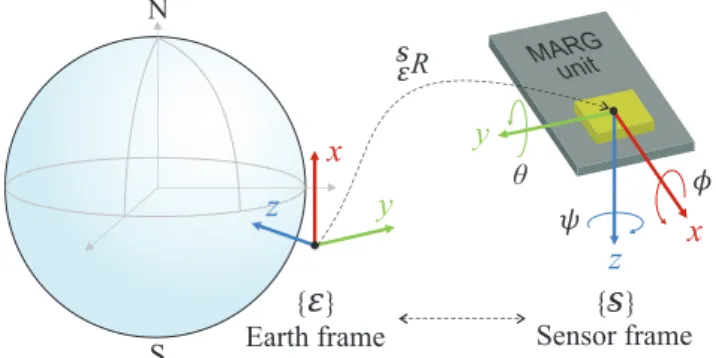
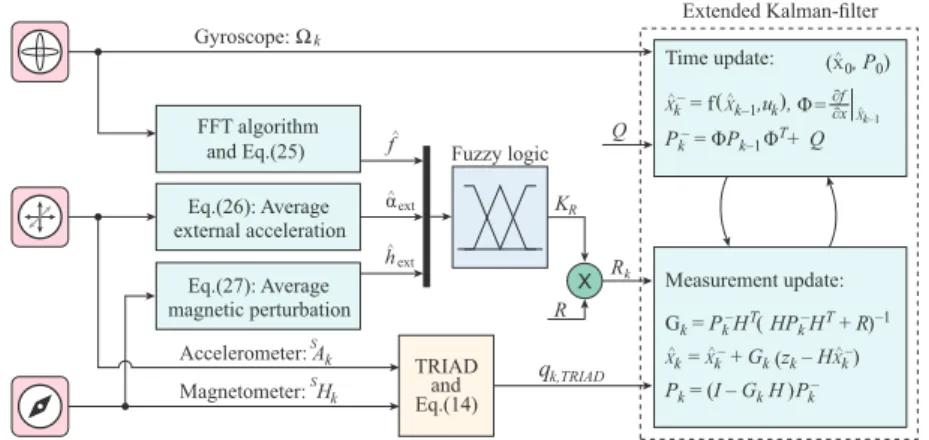
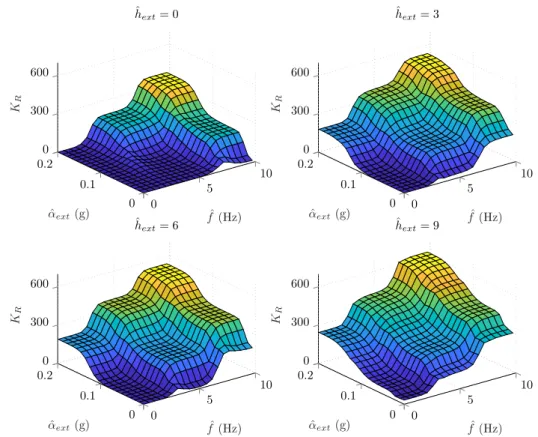
![Figure 5. Block diagram of the test environment and filter tuning procedure (video of the closed-loop in [58]).](https://thumb-eu.123doks.com/thumbv2/9dokorg/970829.57972/17.892.148.744.854.1086/figure-block-diagram-environment-filter-tuning-procedure-closed.webp)
